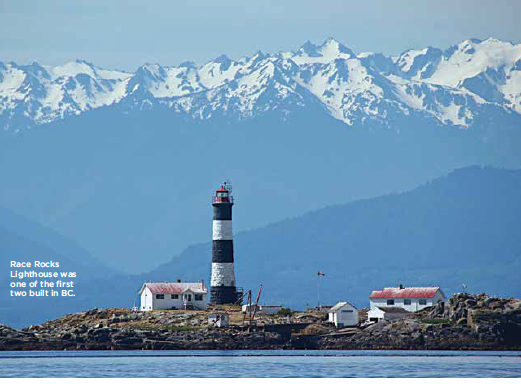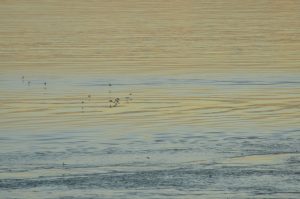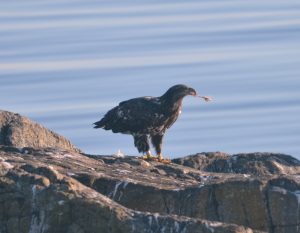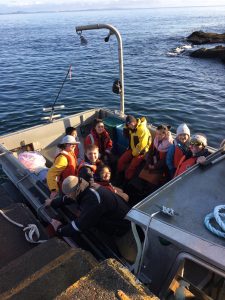GARRY FLETCHER
Marine science teacher and Race Rocks champion
BY MARIANNE SCOTT
 To visit Garry Fletcher at his home requires a drive through the countryside of south Vancouver Island that seems hundreds of miles from the cities that house most of us. His house in Metchosin, near his son’s organic market farm, looks out over sheep trimming the meadow bordering the Juan de Fuca Strait. An espaliered kiwi vine hugs the deck, nectarine and peach trees provide fresh fruit, rhubarb thrives and herbs enliven meals. Garry grew up on a small Saskatchewan farm; it mixed growing food with raising cattle. Farm life inspired his interest in biology, which he studied at the University of Saskatchewan in Saskatoon. After earning a master’s degree in science curriculum, he taught in Swift Current where he met his wife Helen, who taught English. He was then invited to teach biology at the United Nations International School in New York.“They offer an internationally recognized baccalaureate degree,” he said.“But in 1976, after being mugged in the city, we accepted an offer to come to Pearson College, in Metchosin, thinking we’d be here for, maybe, four years.” But Pearson, its students, curriculum and nautical location ensnared him and he and his family have never left.
To visit Garry Fletcher at his home requires a drive through the countryside of south Vancouver Island that seems hundreds of miles from the cities that house most of us. His house in Metchosin, near his son’s organic market farm, looks out over sheep trimming the meadow bordering the Juan de Fuca Strait. An espaliered kiwi vine hugs the deck, nectarine and peach trees provide fresh fruit, rhubarb thrives and herbs enliven meals. Garry grew up on a small Saskatchewan farm; it mixed growing food with raising cattle. Farm life inspired his interest in biology, which he studied at the University of Saskatchewan in Saskatoon. After earning a master’s degree in science curriculum, he taught in Swift Current where he met his wife Helen, who taught English. He was then invited to teach biology at the United Nations International School in New York.“They offer an internationally recognized baccalaureate degree,” he said.“But in 1976, after being mugged in the city, we accepted an offer to come to Pearson College, in Metchosin, thinking we’d be here for, maybe, four years.” But Pearson, its students, curriculum and nautical location ensnared him and he and his family have never left.
PEARSON COLLEGE is a special place. Located on south Vancouver Island’s Pedder Bay, it’s one of 18 United World Colleges and offers a two-year pre-university baccalaureate diploma that covers grade 12 and a gap year for up to 200 students.These students, who represent more than 150 countries, live, study and grow together. Pearson’s mission is to “make education a force to unite people, nations and cultures for peace and a sustainable future.”
At Pearson, Garry began teaching biology, marine science and scuba diving. Jack Matthews, the then College head, gave teachers great freedom to develop their own sphere.“I was able to build an interdisciplinary marine science course that included chemistry, physics and biology,” Garry recalls.“We have this unique situation here at Pearson. Fresh and saltwater, marine ecosystems, forests. I took the class diving, 15 on a boat. We had substantial blocks of time.”
 Meeting Trevor and Flo Anderson, lighthouse keepers at Race Rocks, further revolutionized his teaching and interests. Race Rocks, an archipelago of nine jagged islets lying eight miles from Victoria, is the southernmost point of Pacific Canada.The islands are the pinnacles of a large underwater mountain. The lighthouse was the second to operate in BC and was constructed of Scottish granite brought as ballast aboard British sailing ships.The Rocks are named after the passage separating it from Vancouver Island and has a tidal race reaching seven knots. When strong tides and winds oppose each other, standing waves can grow to 10 feet.The upwelling from the currents provides an exceptionally abundant environment for animal and plant life. Some of the islets are favourite perches for Steller and California sea lions, and elephant seals and harbour seals sunbathe here.
Meeting Trevor and Flo Anderson, lighthouse keepers at Race Rocks, further revolutionized his teaching and interests. Race Rocks, an archipelago of nine jagged islets lying eight miles from Victoria, is the southernmost point of Pacific Canada.The islands are the pinnacles of a large underwater mountain. The lighthouse was the second to operate in BC and was constructed of Scottish granite brought as ballast aboard British sailing ships.The Rocks are named after the passage separating it from Vancouver Island and has a tidal race reaching seven knots. When strong tides and winds oppose each other, standing waves can grow to 10 feet.The upwelling from the currents provides an exceptionally abundant environment for animal and plant life. Some of the islets are favourite perches for Steller and California sea lions, and elephant seals and harbour seals sunbathe here.
“My philosophy of teaching is to instill the concept of ecosystems’ integrity and sustainability,” Garry says.“I explain we’re not on a chain, we’re in a life web. I ask students to � assess their project’s sustainability. Does it have biological integrity? Does it impact the food web or energy flows? What services do ecosystems provide? We must weigh what things will look like in 100 years, not just next year.”
THE LIGHTHOUSE KEEPERS welcomed Garry and students to Race Rocks.“The Andersons knew the uniqueness of the region,”he says.“We dived near the rocks, although with the currents, it could be dangerous. We surveyed and created maps of underwater marine life and collected data on birds and marine wildlife.”
In 1980, this work led to connections with the predecessor to the Ministry of Environment. That ministry managed the “Ecological Reserves” program—areas set aside because of their exceptional natural features, and for their scientific and educational significance. Garry and his students asked the Ministry to add Race Rocks to the list of protected areas.
“Remarkably,”says Garry, grinning,“Prince Charles, the United World Colleges’ chair, came here for a board meeting. We told the ministry the Prince might announce that Race Rocks had become an ecological reserve. Our proposal was approved in record time.”Garry began serving as the Race Rocks Ecological Reserve warden and reported on the Pearson team’s ongoing research. He urges others to propose ecological reserves and has developed an“adopt an ecosystem”template to develop proposals, which can be found online.
MEANWHILE, A MICROWAVE tower delivering live video of island life was built.Two cameras still run today.
� Race Rocks Lighthouse was one of the first two built in BC. Race Rocks Lighthouse was one of the first two built in BC. islands are too small for visitors,” says Garry.“So Pearson grad Ken Dunham developed the network that allowed live- streaming internet video—one of the first such projects in North America. During an Apple conference in New York, I was in a boat off Race Rocks live webcasting with a diver filming underwater (Apple later provided access to live streaming on their network). Our students were very hands-on and we delivered other live webcasts of Race Rocks’ intertidal and subtidal zones to schools. It was new and exciting at the time.”
IN THE ‘90S, David Scott (disclosure—my husband) and Ged McLean and grad students from the University of Victoria’s Institute for Integrated Energy Systems took on separate research studies on the feasibility of obtaining electricity from solar, wind and tidal energy at Race Rocks.“These were tests to determine if any of these alternative energy sources were feasible in this natural laboratory,” says Garry.
A BC ministry funded the solar panels and, with an array of batteries, provided the electricity to help power the islands, thereby reducing the diesel needed to run generators. With additional collectors, they still function today. “The 40 solar panels generate enough power in the summer to make the islands energy self-sufficient,” explains Garry. Solar was judged to be more practical than wind and no windmills were built.
THE CLEAN Current Tidal Power Demonstration Project at Race Rocks was the first such project in Canada and the sponsor, EnCana, wanted to assess if the turbine placed in Race Passage could produce electricity during both ebb and flood currents. UVic and Pearson students collaborated on the project.“This was a case study,” says Garry. “Our students dove often to apply coatings that might prevent fouling of the turbine’s blades.”
Alas, the experiment was discontinued after six years. Photos show that giant barnacles and other ocean life had colonized the turbine. “It was just too expensive to maintain,” says Garry.
Pearson continues its protection of Race Rocks. After the federal government destaffed the lighthouse, the College signed a long-term lease and pays for an eco-guardian to provide a constant human presence on the island.
GARRY, now retired, has been recognized for his imaginative and enthusiastic use of technology in the classroom. He’s active in environmental issues. He condemns the doubling of the Trans Mountain Pipeline and has been an intervenor at the National Energy Board hearings. He cultivates and sells mason bees to augment the population of pollinating insects. He’s analyzed the Race Rocks’ water temperature and salinity data collected since 1921.
“Every month, the median temperature is at least one degree Celsius higher than in 1921,” he warns. As a part of a UVic research program, he’s installed malaise traps on his property to help establish baseline data on insect biomass.
Further reading:
metchosinmarine.ca
ecoreserves.bc.ca
racerocks.ca
gfletcher.ca �

















